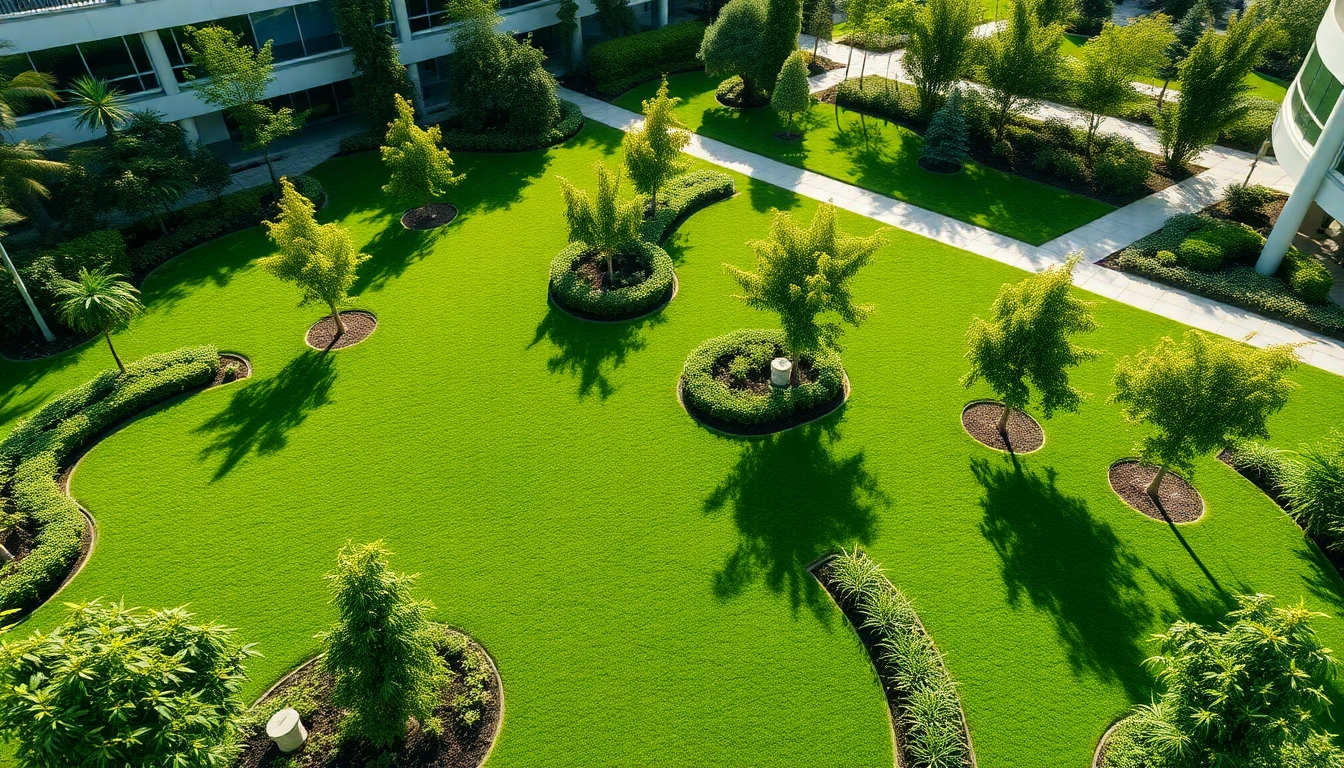Understanding Commercial Landscaping Services
When it comes to maintaining the aesthetic and functional aspects of commercial properties, the role of commercial landscaping contractors cannot be understated. These seasoned professionals provide an array of services tailored to meet the unique needs of businesses, municipalities, and institutions. The modern landscape extends beyond mere beauty; it encompasses strategic design, environmental sustainability, and the enhancement of property value. Understanding the breadth of services offered by these contractors is essential for any business looking to invest in their commercial space.
What to Expect from Commercial Landscaping Contractors
Engaging with commercial landscaping contractors means enlisting experts who specialize in a variety of services. Initially, clients can expect a comprehensive consultation to define their landscaping goals, budget, and design concepts. Here’s what typically follows:
- Site Assessment: Contractors will conduct a detailed analysis of the property. This includes understanding existing flora, soil quality, climate conditions, and the overall use of space.
- Design Proposal: Post-assessment, contractors provide a design proposal highlighting the aesthetic and functional enhancements they recommend. This proposal often includes visual aids like sketches or digital renderings.
- Project Planning: Once approved, the contractor outlines a timeline and project phases. This ensures structured implementation of landscaping features.
- Maintenance Services: Many contractors also offer ongoing maintenance contracts, ensuring that the landscape continues to thrive post-installation.
Types of Services Offered
Commercial landscaping encompasses a broad range of services. Understanding each one can help businesses make informed decisions tailored to their specific needs:
- Landscape Design and Installation: Contractors design and implement landscaping projects that enhance property appeal. This may involve garden beds, trees, and hardscaping features like walkways and patios.
- Grounds Maintenance: Ongoing services that include mowing, trimming, weeding, and general upkeep are vital for maintaining the health and look of commercial landscapes.
- Irrigation Systems: Efficient watering systems are crucial for maintaining green spaces, especially in dry climates. Contractors design and install irrigation systems that conserve water while effectively sustaining plants.
- Seasonal Planting: Implementing seasonal flowers and plants can keep the landscape vibrant throughout the year.
- Hardscaping: This includes non-plant elements such as paths, walls, and patios that improve usability and esthetic appeal.
- Tree Care: Professional tree management, including removal, trimming, and planting, is essential for safety and the longevity of other landscape features.
Industries That Benefit from Landscaping
Various sectors reap the benefits of professional landscaping services, enhancing both appearance and functionality:
- Corporate Offices: Landscaping improves the first impression of clients and visitors, presenting a polished and professional environment.
- Retail Spaces: Attractive landscapes can increase foot traffic and establish brand identity through unique outdoor aesthetics.
- Healthcare Facilities: Thoughtfully designed landscapes contribute to patient recovery and overall well-being.
- Educational Institutions: Schools benefit from landscaped outdoor areas that promote engagement and learning opportunities.
- Hospitality and Leisure: Hotels and resorts utilize landscaping to create inviting atmospheres for guests.
Choosing the Right Contractor
Selecting a commercial landscaping contractor can be an overwhelming process given the variety of options available. Here are key factors to consider:
Evaluating Experience and Expertise
When it comes to landscaping, experience matters. Look for contractors who have a proven record of managing projects similar to yours. Key elements to assess include:
- Portfolio: Review past projects to determine the contractor’s style and the quality of their work. A diverse portfolio indicates versatility in handling different types of landscapes.
- Certifications: Check for relevant licenses and certifications that ensure compliance with local regulations and professional standards.
- Industry Relationships: Reputable contractors often have strong networks with suppliers and local nurseries, leading to better service and competitive pricing.
Important Questions to Ask Potential Contractors
Before making a selection, engage potential contractors with specific questions to gauge their fit:
- What is your process for site assessment and project planning?
- Can you provide references or testimonials from previous clients?
- What are your policies regarding sustainability and environmentally friendly practices?
- How will you handle potential unforeseen issues during the project?
- Who will be the primary point of contact throughout the project?
Checking References and Reviews
References and online reviews can provide insight into a contractor’s reliability and effectiveness. When contacting references, inquire about:
- Work quality and creativity of landscape designs
- Timeliness of project delivery
- Responsiveness to client feedback and ability to adapt
- Post-project support and maintenance service quality
Cost Considerations for Commercial Landscaping
A well-planned landscaping project can greatly enhance property value and appeal. However, understanding the costs involved is essential for effective budgeting.
Average Pricing Models Explained
Costs for commercial landscaping can vary widely based on scope and location. Significant factors influencing costs include:
- Project Size: Larger projects typically come with a higher total cost, but the price per square foot may decrease with volume.
- Service Type: The cost of different services varies, with installations generally being more expensive than maintenance.
- Seasonal Considerations: Certain times of the year may see higher rates due to demand, especially during spring and fall.
Factors Influencing Landscaping Costs
Accurate budget allocation requires an understanding of the various factors that can affect landscaping prices:
- Local Market Rates: Costs can vary considerably depending on geographic location. Urban areas may have higher labor and material costs than suburban or rural areas.
- Site Conditions: If significant earthwork is necessary, such as grading or drainage issues, overall costs can increase.
- Material Choices: The choice of plants, hardscaping elements, and technology will significantly influence expenses. Higher quality, more robust materials often come with steeper costs.
Budgeting Tips for Businesses
Creating a landscaping budget involves careful planning to ensure funds are allocated effectively while allowing for flexibility. Consider these strategies:
- Get Multiple Estimates: Obtain quotes from several contractors to gain a competitive understanding of costs and available services.
- Prioritize Projects: Budget for immediate needs while leaving room for future enhancements. This step allows businesses to invest gradually without overwhelming financial strain.
- Account for Maintenance: Regular upkeep is critical; include maintenance costs in your overall landscaping budget.
Trends in Commercial Landscaping
As the industry evolves, commercial landscaping contractors are adopting new trends and practices to meet client needs and environmental standards.
Sustainable Practices in Landscaping
With growing ecological awareness, sustainability has become a focal point of modern landscaping. Key sustainable practices include:
- Native Plant Usage: Utilizing plants that are native to the area minimizes water usage and maintenance while supporting local ecosystems.
- Water Conservation Techniques: Implementing rain gardens and xeriscaping reduces the need for irrigation, thereby conserving water.
- Organic Fertilizers and Pesticides: These alternatives are less harmful to the environment and promote healthier landscapes.
Innovative Technologies in Landscape Maintenance
Technology is increasingly influencing landscape maintenance practices, bringing efficiency and cost-effectiveness:
- Smart Irrigation Systems: These systems automatically adjust watering based on weather conditions, optimizing water usage.
- Drones for Monitoring: Drones provide an aerial perspective of large properties, helping to monitor growth, pest issues, and irrigation effectiveness.
- Landscape Management Software: Cloud-based solutions enable contractors to schedule maintenance, manage resources, and communicate with clients seamlessly.
Design Trends for Commercial Properties
Modern landscaping is also being shaped by design trends aimed at enhancing user experience:
- Outdoor Workspaces: As remote work becomes more prevalent, businesses are creating outdoor areas designed for meetings and collaboration.
- Edible Landscapes: Incorporating fruit trees, herbs, and vegetables into designs not only beautifies the landscape but also contributes to sustainability.
- Wellness-Oriented Designs: Landscapes promoting wellness through the inclusion of meditation gardens, walking paths, and natural seating are gaining popularity.
Measuring Success and ROI of Landscaping Investments
Investing in landscaping should yield measurable returns. Businesses must track the impact of their landscaping efforts to justify expenditures.
Key Performance Indicators for Landscaping
When assessing the impact of landscaping investments, consider the following KPIs:
- Increased Foot Traffic: Tracking customer visits pre and post-landscaping can indicate the success of attracting clientele.
- Employee Satisfaction: Employee feedback on outdoor spaces can reveal how landscapes contribute to workplace morale and productivity.
- Property Value Increase: Monitoring changes in property value post-landscaping can provide clear financial justification for investment.
Feedback from Clients and Stakeholders
Soliciting feedback from clients, employees, and stakeholders is critical in understanding the effectiveness of landscaping. Techniques include:
- Surveys: Regularly distribute surveys to gather input on landscape impact and desired improvements.
- Focus Groups: Inviting a range of stakeholders to discuss landscaping can yield valuable insights and innovative ideas for future designs.
Next Steps for Enhanced Commercial Landscaping
Once landscaping investments are made, continuous improvement is essential. Future steps may involve:
- Monitoring Trends: Stay updated on landscaping trends and technologies to adapt and maintain relevance.
- Continuous Training: Provide training for maintenance staff on new practices and technologies to keep landscape standards high.
- Regular Updates and Enhancements: Consider periodic renovations to adapt to changing market conditions or shifts in company direction.



